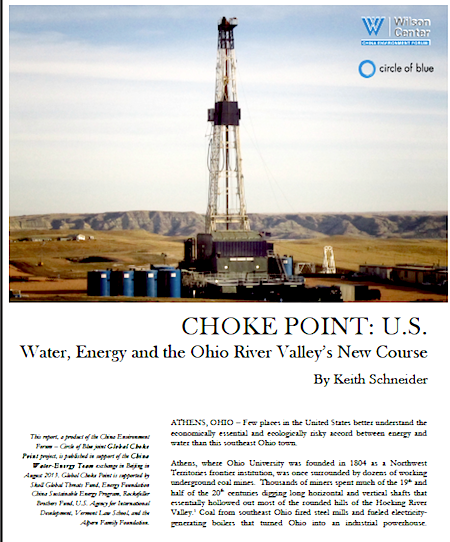
ATHENS, OHIO – Few places in the United States better understand the economically essential and ecologically risky accord between energy and water than this southeast Ohio town.
Athens, where Ohio University was founded in 1804 as a Northwest Territories frontier institution, was once surrounded by dozens of working underground coal mines. Thousands of miners spent much of the 19th and half of the 20th centuries digging long horizontal and vertical shafts that essentially hollowed out most of the rounded hills of the Hocking River Valley. Coal from southeast Ohio fired steel mills and fueled electricity-generating boilers that turned Ohio into an industrial powerhouse.
Then, as now, water was critical to every stage of the mining, processing, shipping, and burning of coal in southeast Ohio, which is at the center of the six-state Ohio River Valley. The ecological consequences of the rugged, unregulated mining before 1950 are manifest in a present day water mess. Water fills the dormant shafts and pours out of the old mines of the Hocking Valley in springs and streams so saturated in trace minerals they are too acidic for aquatic life to survive.

Natalie Kruse, a hydrogeologist and assistant professor at Ohio University, has distinguished her young academic career through research to develop practices that restrain the acid mine drainage, and restore some streams to conditions that support small fisheries. In that sense, Dr. Kruse is a kind of capstone figure working to clean up the remnant byproduct of Ohio’s first great era of carbon-fueled development.
Dr. Kruse, though, is also emerging here as a prominent researcher helping citizens and state officials gain a clearer understanding of the effects on the state’s freshwater reserves from Ohio’s next chapter of hydrocarbon production. More than a mile beneath east and southeast Ohio, and much of Pennsylvania and West Virginia, lies an astonishing abundance of natural gas embedded in the deep hydrocarbon-rich shales of the Utica and Marcellus geologic formations. In the last five years, over 8,000 deep Marcellus shale gas wells were drilled in Pennsylvania, and 1,700 were drilled in West Virginia. Ohio’s Utica shale gas developers have drilled 367 wells since 2010, when the natural gas boom started in this state.
The sudden surge of natural gas is the most important factor in why federal figures show that coal production and electrical generation fueled by coal, the dirtiest fuel, have declined since 2010 in the Ohio River Valley. Utilities in Ohio and the other states along the 981-mile Ohio River, which stretches from Pittsburgh to Cairo, Illinois, are opening more natural gas-fueled turbines, the newest of which operate with far lower requirements for cooling water, and don’t have fuel piles that pollute waterways. Emissions of climate-changing gases are falling because carbon emissions from burning gas are 40 percent lower than from burning coal.

The readily apparent and well-documented benefits of the surge in fuel supplies, though, are pitched on the slippery rocks of watery risks. Developers bring the gas to the surface by pumping, at ultra-high pressure, a 4-million to 6-million-gallon mixture of sand, water, and chemicals into each well to fracture the rock and release the fuel. Gas developers build roads, pipelines, and processing infrastructure at heavily wooded drill sites, often in steep terrain. The result is deforestation, erosion, and siltation in mountain streams.
Earlier this month, in support of a Wilson Center-Circle of Blue speaking tour in Beijing, I prepared a paper that updates the findings of our 2010 Choke Point: U.S. report. That project identified the Southwest, Great Plains, and Southeast as the regions at greatest risk of shortages of energy and water. Choke Point: U.S. also reported that access to adequate supplies of water and wastewater treatment were the primary impediments to the shale oil and shale gas production boom overtaking the country.
A special focus of this new paper — available on the Circle of Blue Web site here — is to explore energy production and water supply in Ohio and its neighboring Ohio River Valley states. The development of natural gas and natural gas liquids from deep shale is reshaping long-standing trends in the region’s energy mix, water consumption and treatment patterns, climate emissions, and economy. Moreover, global trends in energy and food supply and water use, especially in China and the Persian Gulf, are dramatically influencing natural gas and oil development, coal consumption, food production, water use, and the economy along the Ohio River Valley.
The six-state region is now a useful laboratory to understand how the convergence of new domestic energy technology, and overseas water, energy and food production patterns form an interlocking web of market signals that affect U.S. state economies and environmental conditions. Growing demand for grain in Asia and the Persian Gulf has produced record-high prices for corn and soybeans in the U.S. over the last five years. Rising demand for grain, and for energy, also prompted higher sales of the planting, harvesting, and construction equipment made by John Deere, International Harvester, and Caterpillar in the Ohio River Valley states.
Asia’s rising demand for coal, to fuel its fast-developing economies, is propping up prices in the Ohio, West Virginia, and Kentucky coal industry, which is exporting more coal than ever before to Europe, and putting pressure on Oregon, Washington, and British Columbia to open a western deepwater port for American coal exports to Asia.
China’s growing demand for liquid fuels keeps oil prices high enough to finance the expensive development of shale oil in the U.S.. Demand from China, and the higher prices international consumers pay for natural gas and natural gas liquids is prompting U.S. shale gas developers to produce enough methane, ethane, and propane to export from the Ohio River Valley states to overseas markets. Congress is debating whether to lift export restraints on natural gas and natural gas liquids, and new export terminals are proposed on the Atlantic and Gulf coasts.
The expanding markets for natural gas in the U.S., and in global markets, has produced mounting sales in support industries, including the construction of five new steel plants in Ohio since 2011, the first new plants since the 1980s.
The steady expansion of Ohio’s gas fields, along with smaller increases in renewable energy production, is part of a similarly powerful and, to some extent, surprising pivot point transition that is occurring across the United States in the energy and water sectors. America, alone among the world’s big economies, appears to be accomplishing a feat that nobody forecast just three years ago. Simply put, the United States is using less energy, growing its economy, and steadily shifting to cleaner, less water-consuming fuel sources.
For a full copy of the report click here.
— Keith Schneider


One thought on “Water, Energy and the Ohio River Valley’s New Course”